With the Burgundy 2016 campaign underway, our first blog of the new year sheds some light on an all too often complex region. In our inaugural Burgundy study, Wine Lister reveals some key findings. Read on to find out more or click here to access the full study (non-subscribers can see a preview of the study here).
Price: the unstoppable force?
While the region’s Brand scores are no match for Bordeaux, Burgundy’s supply and demand dynamic(emphasised by a five-year stock shortage) and high quality are driving prices ever skywards. The majority of top Burgundy wines cost between £100 and £500 a bottle, with 18 wines costing more than £2000 per bottle.
Among the impressive Economics scores (994 being the highest) it is no surprise that producers such as Domaine de la Romanée-Conti (DRC) and Domaine Leroy hold many of the top spots (note that the only whites to enter into the Top 25 for Economics are from Coche-Dury). However, the region as a whole rises above the rest on price performance. Burgundy‘s prices have risen more quickly than any other top fine wine region and show no sign of decelerating.
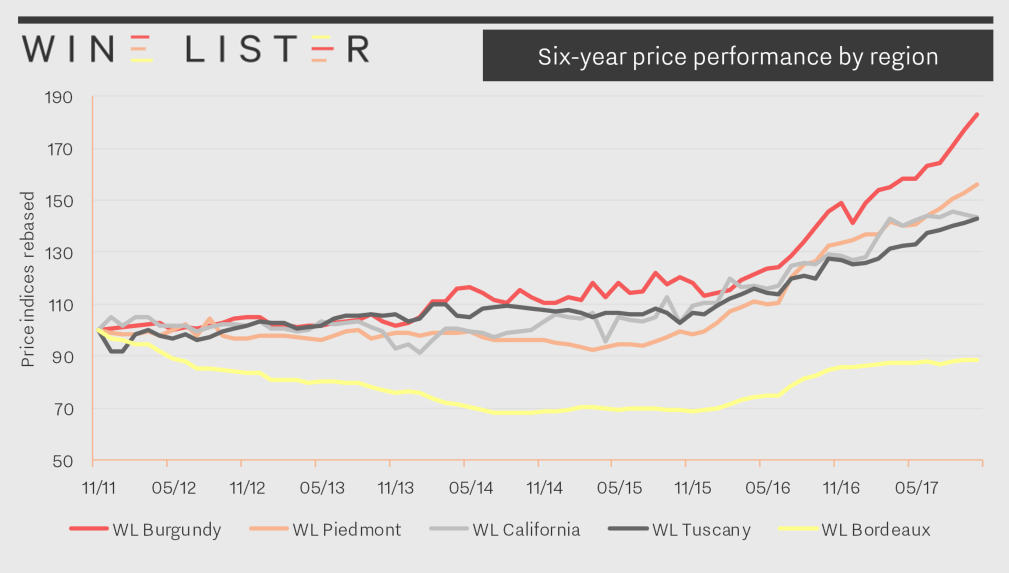
Quality: the clear winners
Indeed, DRC and Domaine Leroy consistently top the charts across all Wine Lister scores. However, Lalou Bize-Leroy is Quality queen, with 11 wines in the Quality top 25 between Leroy and d’Auvenay.
DRC and Armand Rousseau stand out as being the only two producers to gain the trade’s full confidence. Our Founding Members give the domaines a confidence rating of 10/10 (no Bordeaux chateau scores above 9/10).
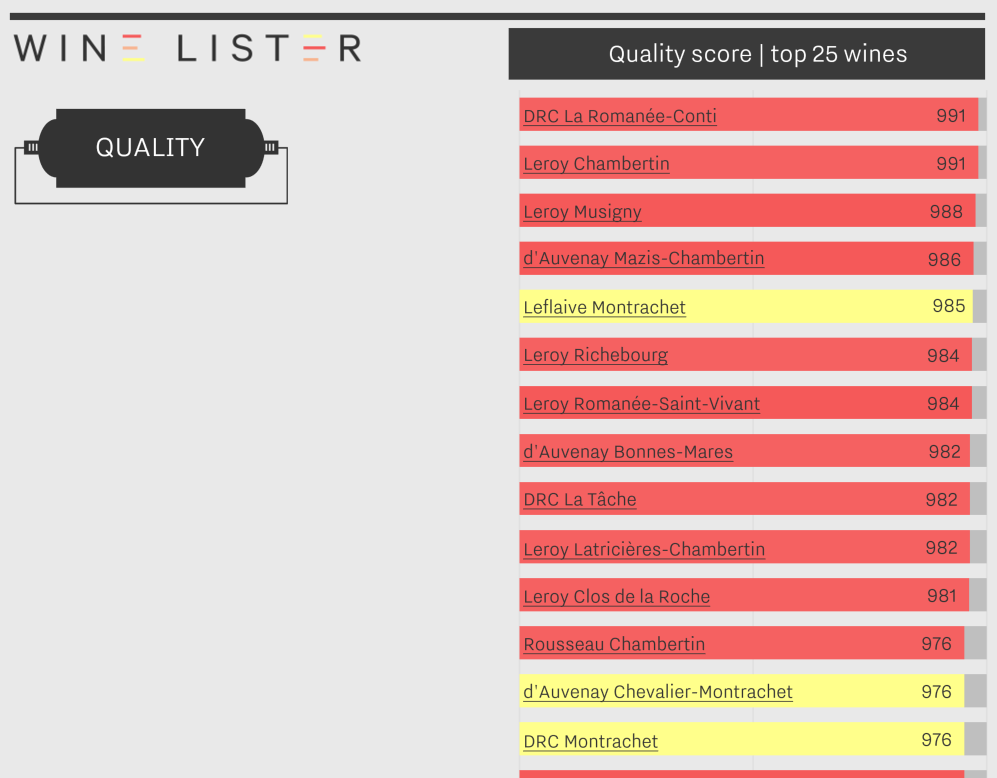
Trends: what the future holds for Burgundy
Further insight from Wine Lister’s 52 Founding Members (key global fine wine trade figures)includes growth trends for Burgundy.
One commonality throughout the trade was the noticeable rise in the popularity of Saint-Aubin (Burgundy is the region home to more “rising star” producers than any other fine wine region). Other observations included a general shift towards higher quality and greater purity in winemaking style, as well as less sulphur and more whole bunch fermentation.
Subscribers can read the full study here. Non-subscribers can access a preview of the full version or subscribe here.
December is an expensive month, a time when many of us push the boat out, embracing the seasonal festivities as the days get ever shorter and the nights longer. But December has now been and gone, and January is here. Whilst it is a time for trying to tighten one’s belt – economically and physically – it needn’t be all doom and gloom.
This is where Wine Lister’s Value Picks come in to their own. One of Wine Lister’s four indicators (designed to highlight particularly noteworthy wines for our subscribers), Value Picks identify the wines and vintages that have the best quality to price ratio (with a proprietary weighting giving more importance to quality, thus giving the finest wines a look-in). This week’s Listed section looks at Spain’s top five Value Picks. Each achieving Quality scores of at least 876, and costing under £40 per bottle, they are sure to brighten up these dark January days. Please note that the prices shown are excluding duty and VAT, and often reflect prices available only when purchasing a full case.
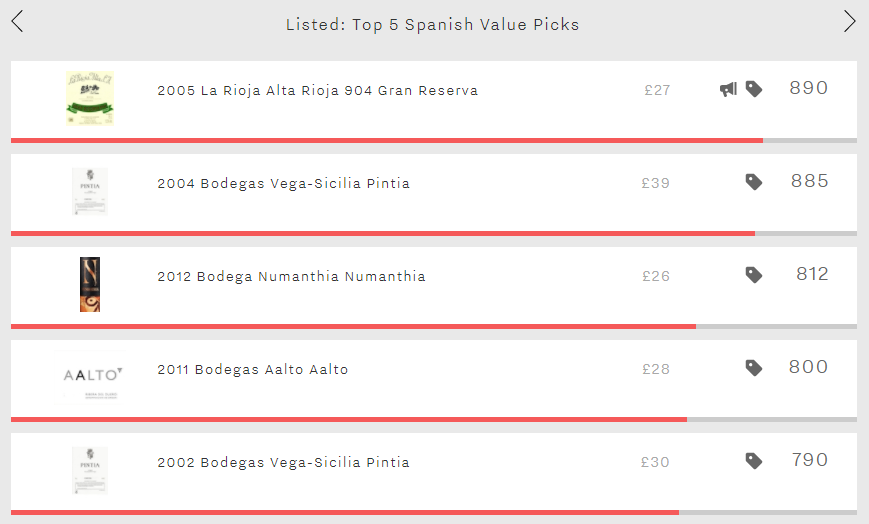
Leading the way is La Rioja Alta Rioja 904 Gran Reserva 2005. With an excellent Quality score of 909, this is a wine that is built to last – it is only now entering its drinking window, and will be drinking well until 2032. Not only does it qualify as a Value Pick, it is also one of Wine Lister’s Buzz Brands. Available for as little as £27 per bottle, it represents outstanding value.
Vega-Sicilia Pintia fills two spots, with the 2004 and 2002. They enjoy the group’s top two highest Quality scores (987 and 965 respectively), having received excellent ratings of 19/20 and 18/20 from Wine Lister partner critic Jancis Robinson. They need drinking up now, so why not start the year as you mean to go on and get your hands on one (or both!) of these.
Numanthia 2012, on the other hand, won’t be ready until 2022. The cheapest of the group – at as little as £26 per bottle – it might be wise to buy a case and forget about it for a few years. Achieving a Quality score of 876, you won’t regret finding a bottle of it tucked away in January 2028!
The last of Spain’s top five Value Picks is Aalto 2011. With a Quality score of 920, and right in the middle of its drinking window, it would be £28 of liquid Spanish sun to brighten up the month.
Following on from our recent blog in which we looked at the five wines that enjoyed the greatest absolute increase in online search frequency during November, we thought it would be interesting to look at the five wines whose improved popularity had the biggest impact on their Brand score. This throws up some less obvious candidates.
Alongside presence in the world’s best restaurants, Wine Lister’s Brand score measures a wine’s online popularity – as indicated by the number of searches received on Wine Searcher – as a marker of real consumer demand. The five wines below do not come close to rivalling the phenomenal popularity of the first growths and company whose search frequency increased the most in absolute terms in November. However, the relative change in their online search frequency led to some significant improvements in their Brand scores.
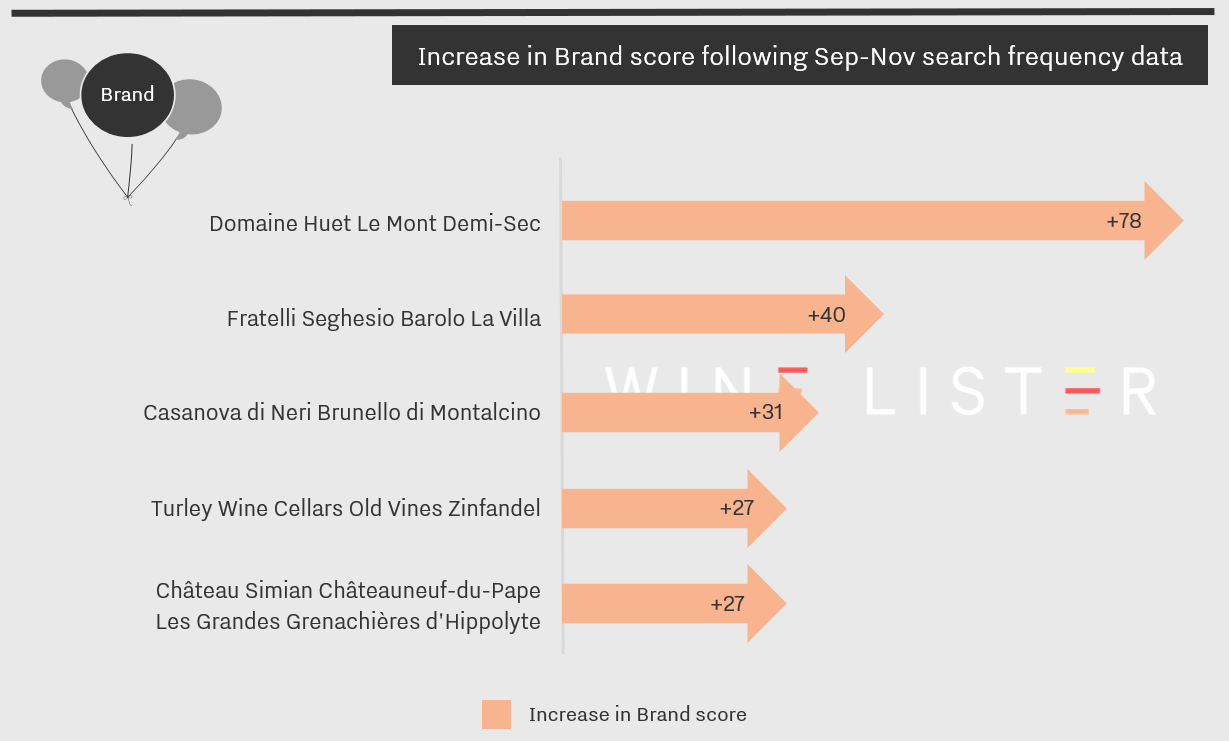
Whilst each of the five experienced an increase of at least 44% in their online search frequency, Domaine Huet Le Mont Demi-Sec’s surged 147% during November, resulting in a whopping 78-point gain in its Brand score (now 765), tipping it into the very strong category on Wine Lister’s 1,000 point scale. Its sharp increase in online popularity might be the result of the 2016 vintage being named the sixth best wine in the world by Wine Spectator last month. Whilst the 2016’s Wine Lister Quality score (917) can’t quite match the performance of two of Domaine Huet’s sweeter cuvées for the vintage, it appears that it is a brand on the up.
Next comes a duo of Italian reds – Fratelli Seghesio Barolo La Villa and Casanova di Neri Brunello di Montalcino. Starting from a low base of just 243 searches each month, the Piedmontese red’s search frequency leapt 63% to 396, resulting in a 40-point increase in its Brand score (506). In stark contrast, Casanova di Neri’s straight Brunello already benefitted from a high level of online popularity, previously receiving 1,791 searches each month on average. It’s 72% increase in search frequency – again presumably thanks to the 2012 vintage’s fourth spot in Wine Spectator’s top 100 wines – has resulted in a new Brand score of 799, the highest of the group.
Last but not least, Turley Wine Cellars Old Vines Zinfandel and Château Simian Châteauneuf-du-Pape Les Grandes Grenachières d’Hippolyte both enjoyed a 27-point increase in their Brand score with the latest search frequency data. Whilst their overall Wine Lister scores are fairly similar (605 and 577 respectively), their profiles differ markedly. The Californian red performs best in the Brand category, its new score of 650 comfortably outperforming its Quality and Economics scores (593 and 552 respectively). Conversely its Old-World peer has a weak brand (327), well below its very strong Quality score (808) and average Economics score (498).
It will be interesting to see if these brands continue to strengthen in 2018. Speaking of which, the Wine Lister team wishes you all a Happy New Year!
With the latest online search frequency data in from Wine-Searcher, we can see which wines rose in popularity during November. Each month we look at the last three months’ worth of search data, measured against the previous period, to see which wines have grown most in popularity. With five of the world’s six most popular wines making the greatest gains during November, it appears that demand for the biggest brands shows no sign of diminishing, and that the public is quick to pick up on announcements regarding the most famous fine wine producers.
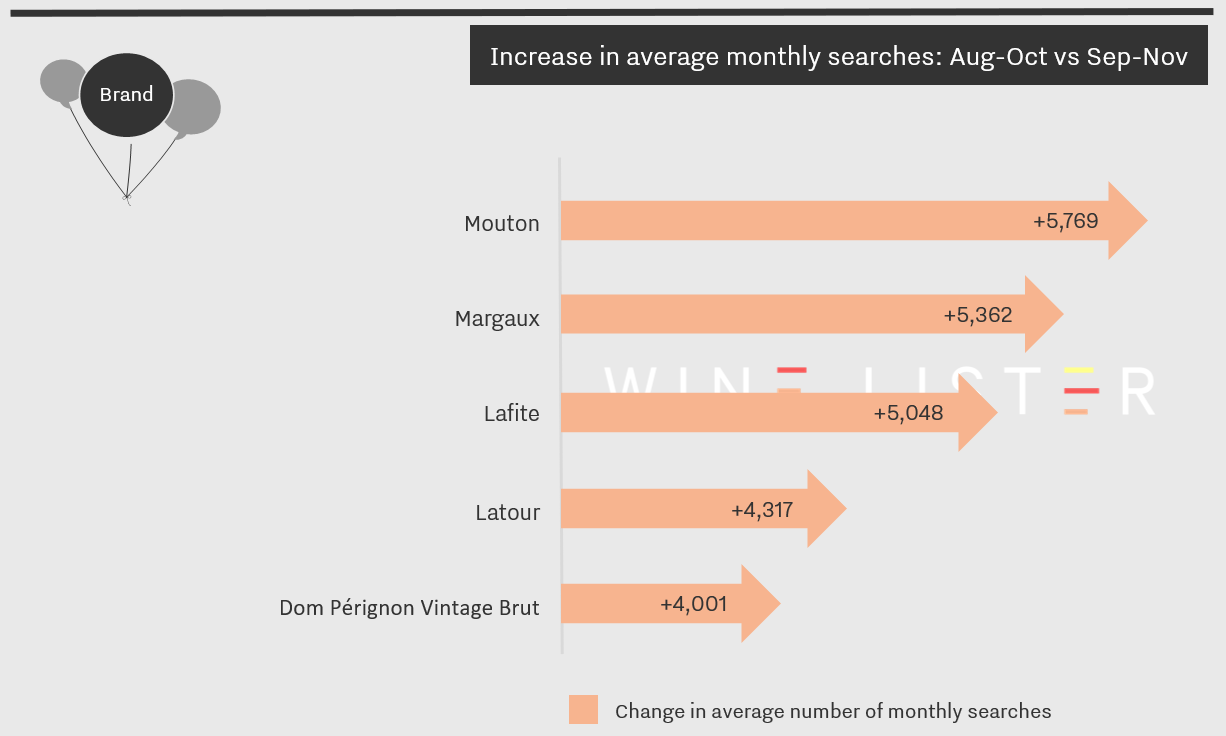
Mouton, the world’s second-most popular wine, made the greatest gains during November. This is likely thanks to the release of the label for the 2015 vintage. It features a witty juxtaposition of Gerhard Richter’s “Flux” with the reiteration of part of Mouton’s motto, “Mouton ne change” (Mouton never changes), in the context of a generational shift as Philippine de Rothschild’s three children take the helm after her death in 2014.
Snapping at Mouton’s heels was Margaux. It too announced during November that it will release its 2015 vintage in a commemorative bottle – the first time the château has done so – paying homage to Paul Pontallier who was winemaker at the property for almost 30 years. With Margaux 2015 achieving one the best Quality scores of the vintage, it seems a fitting tribute.
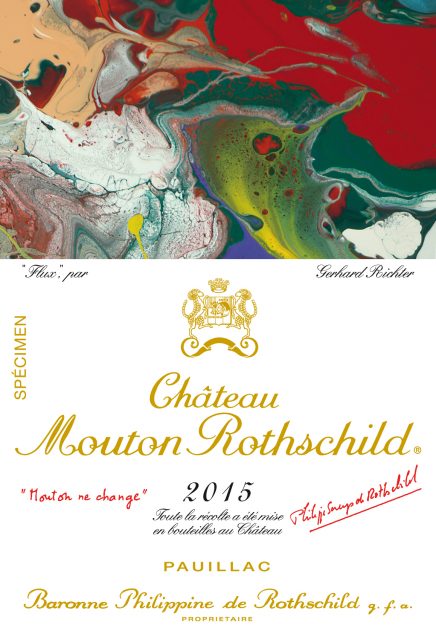
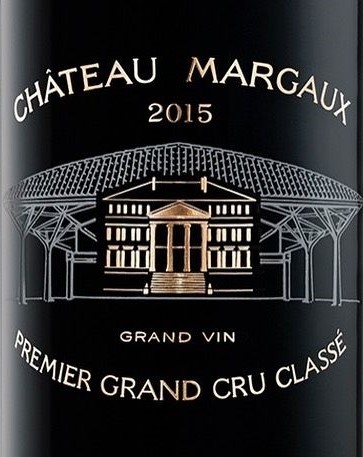
Lafite came next. In mid-November it was announced that in March 2018 Saskia de Rothschild will be taking over as chairwoman of the château and Jean-Guillaume Prats of Moët Hennessy will become President and CEO. With Lafite currently the most popular wine in the world, and one of just five wines on Wine Lister to achieve a Brand score of 999 – alongside Dom Pérignon Vintage Brut, Mouton, Latour, and Yquem (no wine scores 1,000) – the duo have a formidable reputation to maintain.
Latour was the fourth-biggest gainer, its search frequency increasing 8% (4,317 searches). Whilst the increased interest in the other Médoc first growths can be attributed to a significant announcement, the reason behind Latour’s surge in popularity is less obvious. Related news is of course the acquisition by Artemis Domaines – Latour owner François Pinault’s holding company – of Burgundian Grand Cru monopole Clos de Tart.
Breaking the Bordeaux first growths’ dominance on this month’s popularity stakes was Dom Pérignon, a brand whose online popularity has soared over the second half of the year. Early in November Moët Hennessy announced the launch of Clos19, an online shop selling its prestigious brands – one of which is Dom Pérignon. Cannily introduced before the festive season, during which Champagne’s popularity surges – it seems that the region’s strongest brand has further benefited from the new platform.
Having considered Chambertin’s top five wines for Quality last week, this week our Listed section travels south-west to look at Margaux’s overall best red wines. Whilst it is to be expected that Margaux’s eponymous first growth tops the table, with an outstanding score of 970, the order of the remaining four wines – and the appearance of second wine Pavillon Rouge – might come as more of a surprise.
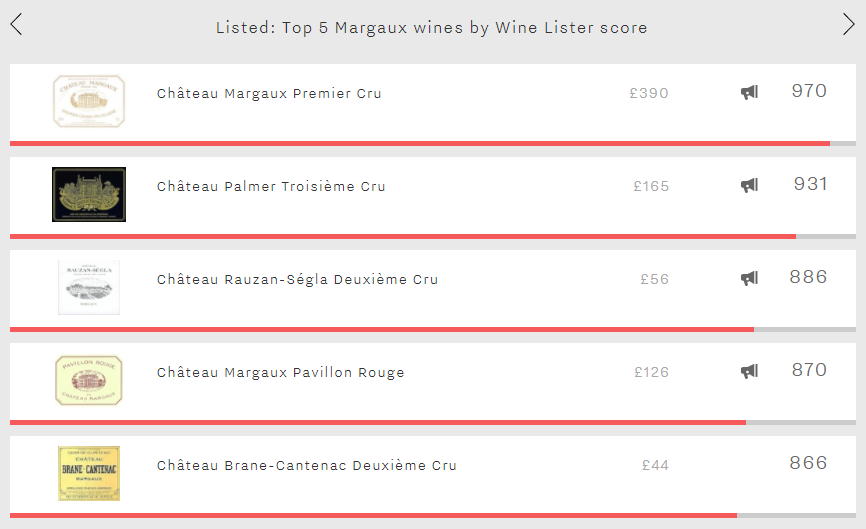
Château Margaux’s dominance is the result of a lead across nine of Wine Lister’s 12 rating criteria, resulting in an advantage in both the Quality and Brand categories. In particular, it outperforms the others in the Quality category with an excellent score of (962), nearly 80 points ahead of the second-best wine in the category – Palmer (885), which leapfrogs the group’s two second growths in terms of quality. However, Château Margaux is pipped to the post in the Economics category by Pavillon Rouge, whose superior price performance helps it to overcome its older sibling.
Palmer achieves Margaux’s second-best overall score (931). The third growth’s brand is its strongest asset. Despite trailing Château Margaux by two points in the category, its score of 995 is the 15th best Brand score in the entirety of Wine Lister’s database. It even sneaks ahead of Château Margaux in terms of restaurant presence (47% vs 46%), although it can’t quite match its illustrious neighbour in terms of vertical presence, with 4.1 vintages / formats offered per list on average, compared to Château Margaux’s 5.7. It is also searched for nearly three times less frequently than Château Margaux.
Pavillon Rouge occupies fourth position. It enjoys the group’s best Economics score, in-keeping with the unstoppable performance of first growths’ second wines in general. This is the result of strong price growth rates – it has a three-year compound annual growth rate (CAGR) of 15.5% and has added over 11.3% to its price in the last sixth months alone. The chart below confirms that its economic strength is not only at odds with its lack of classification, but also with its Quality score, which is the lowest of the group.
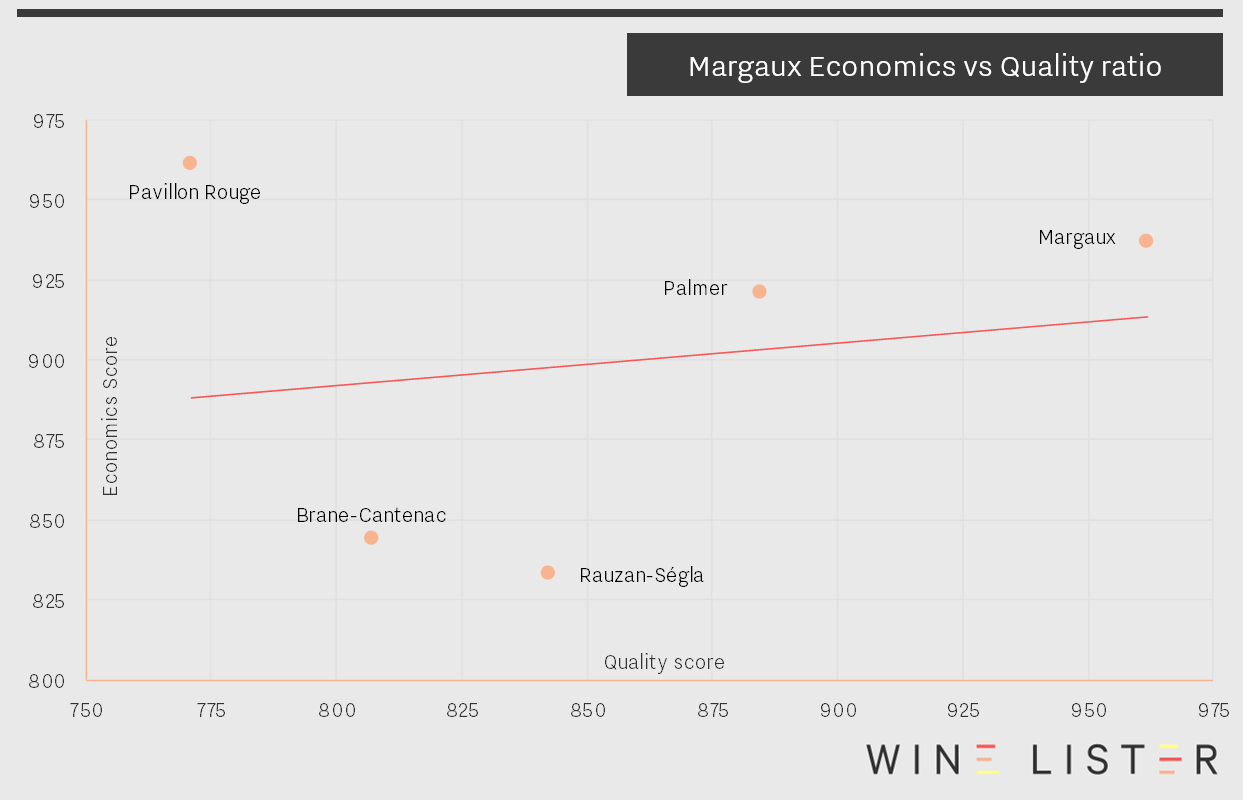
Pavillon Rouge is sandwiched between two second growths – Rauzan Ségla (886) and Brane-Cantenac (866). Despite belonging to the same class, they perform quite differently. Rauzan-Ségla experiences the group’s weakest economic profile (836), but climbs back up the table in the Quality and Brand categories (842 and 970 respectively), ahead of fifth-placed Brane-Cantenac.
Any of these wines would be a very worthy addition to your Christmas table. Happy Christmas from the whole team at Wine Lister!
If ever there was a time of year to push the boat out, then surely this is it. So this week our Listed section travels to Burgundy for Chambertin’s top five wines for Quality. All achieving a Quality score of at least 966, thus ranking amongst the very best on Wine Lister’s database, these are some of the most sought-after wines in the world.
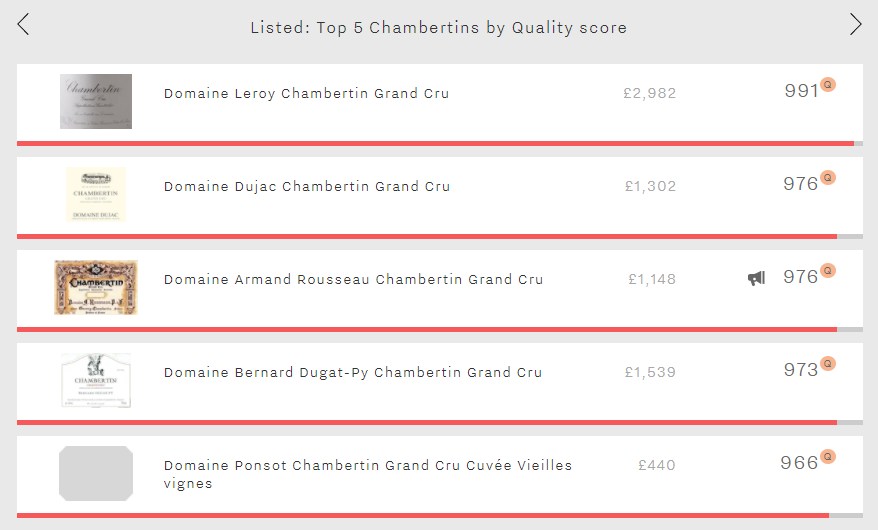
Leading the way with a score of 991 is Leroy’s offering. This exceptional score is the third-best Quality score on Wine Lister and the highest of any red wine (alongside DRC La Romanée-Conti). Across all vintages, it receives near-perfect ratings from Wine Lister partner critics Jancis Robinson and Jeannie Cho Lee (19.5/20 and 99/100 respectively). Moreover, Jeannie Cho Lee awarded a 100 point score to the 2015 vintage. But with the longest ageing potential of the group – over 18 years on average – the 2015 will reward patient drinkers, and with a wine-level average price of £2982 per bottle, you would want to savour it at its peak.
Next come Dujac and Rousseau’s offerings with scores of 976. Whilst these wines achieve identical Quality scores, and similar Economics ratings (951 and 979 respectively), the Rousseau achieves a far superior Brand score (960 vs 608). In fact Rousseau’s Chambertin convincingly outperforms the others in the Brand category, which achieve an average score of 638. The chart below confirms that Rousseau’s Chambertin enjoys far greater brand recognition than its Quality score would suggest within this set of peers, definitely earning its Buzz Brand status.
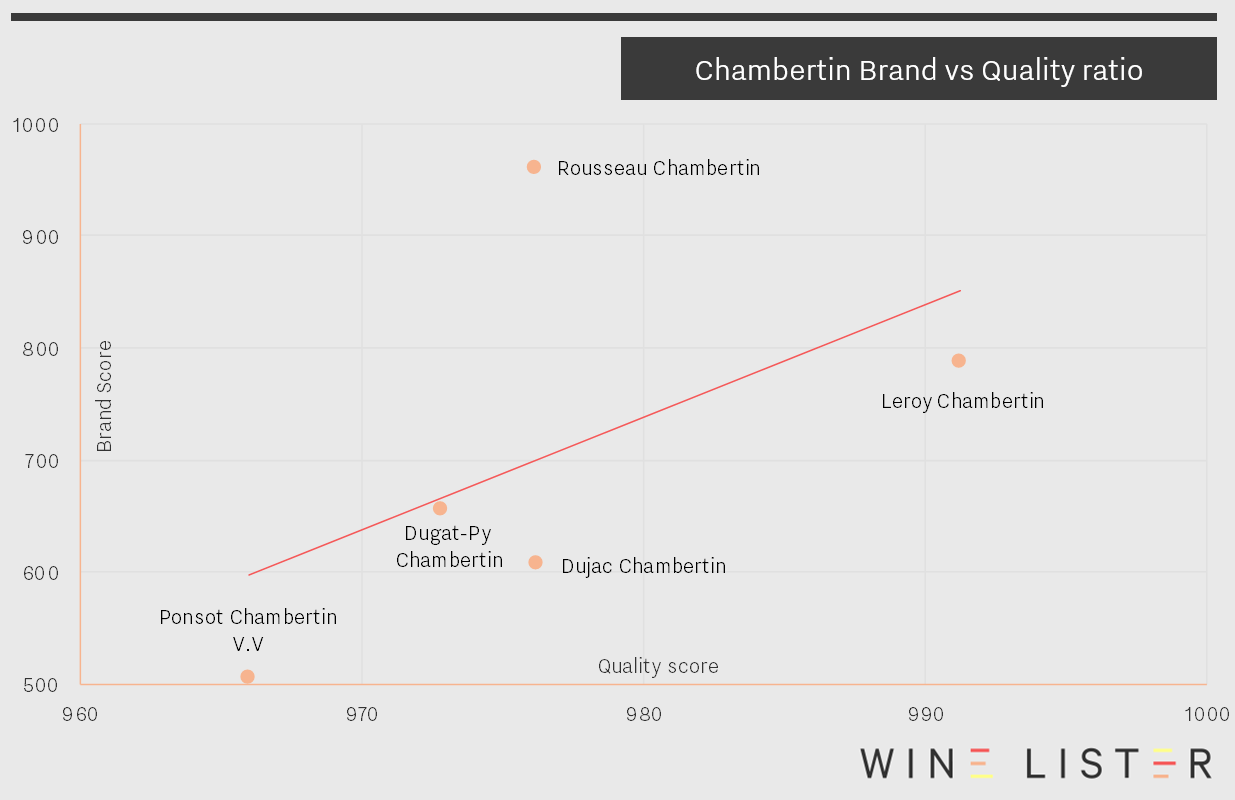
In fourth place is Dugat-Py’s Chambertin (973), just seven points ahead of Ponsot’s Chambertin Cuvée Vieilles Vignes (966). Despite their similar Quality scores, there is a noticeable difference in their prices, with the Dugat-Py the second most expensive wine in the group (£1539), whilst the Ponsot is by far the cheapest (£440) and looks relatively good value. If we look a little further, Ponsot Chambertin 2007, with a Quality score of 968 is currently available for as little as £399 per bottle and is in the middle of its drinking window, making it an excellent proposition for that seasonal treat.
If you are interested in Burgundy and its position in the fine wine market, then watch this space for our forthcoming in-depth regional study, due to be released in January.
Christmas is a time of tradition. Whether we like it or not, we tend to spend each year doing, eating, and drinking the same as we did the year before. Whilst everybody’s idea of Christmas will be personal, usually based on childhood memories, there are clearly a shared set of rituals that most of tend to follow: mince pies, turkey or goose, crackers, Christmas pudding. There are also certain styles of wine that we associate with Christmas (though these associations are probably not based on childhood memories!). We decided to look a bit further into the online popularity of specific regions and styles of wine to determine whether in fact we do all drink the same things over the festive season.
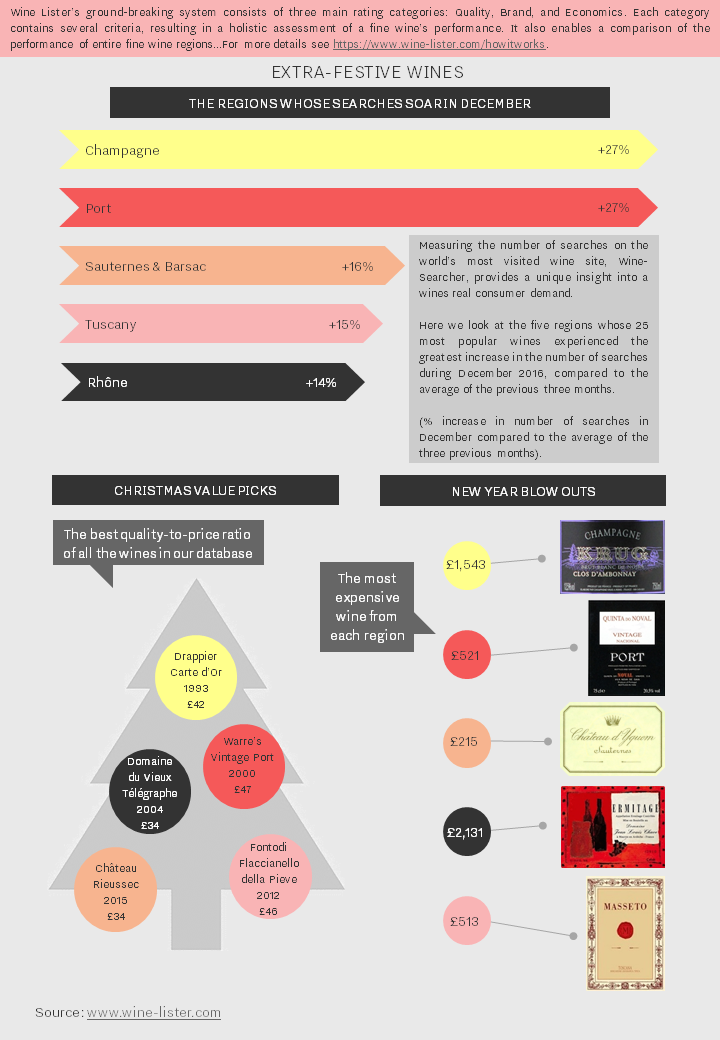
Comparing the search frequency of each region’s 25 most popular wines on Wine-Searcher during December 2016 compared to the average of the previous three months, the results are conclusive. Champagne and Port both enjoyed a dramatic surge in popularity – receiving over a quarter more searches during December. Whilst Port’s dramatic increase in online search frequency was presumably because it is the classic accompaniment to another festive favourite – Stilton – Champagne’s seasonal rise in popularity must be because it is not just the tipple of choice at Christmas parties, but also at New Year’s celebrations.
It seems that we also tend to favour the sweet whites of Sauternes and Barsac over Christmas, their 25 most popular wines enjoying a 16% increase in online search frequency. When it comes to dry reds, we appear to gravitate towards hearty styles at this time of year, with Tuscany and the Rhône also experiencing noticeable boosts in online popularity (up 15% and 14% respectively).
If you haven’t yet stocked up on those perennial favourites, Wine Lister’s Value Pick search tool can help you effortlessly find top Quality at a reasonable price. Each of our Christmas Value Picks achieves an outstanding Quality score of at least 965, putting them amongst the very best on Wine Lister. With the most expensive – Warre’s Vintage Port 2000 – available for as little as £47, they represent remarkable value.
If you are after a really special bottle for New Year’s, then we also show the most expensive wine from each region. Each of these wines qualify as Wine Lister Buzz Brands, and is sure to help start 2018 with a bang.
Download a PDF version here.
First published in French in En Magnum.
Wines featured: Drappier Carte d’Or 1993; Domaine du Vieux Télégraphe Châteauneuf-du-Pape 2004; Rieussec 2015; Fontodi Flaccianello della Pieve 2012; Krug Clos d’Ambonnay; Quinta do Noval Porto Nacional Vintage Port; Château d’Yquem; Jean-Louis Chave Hermitage Cuvée Cathelin; Masseto
Bodegas Vega-Sicilia has today released a host of wines. Alongside the 2018 edition of Unico Reserva Especial (£240 per bottle / £720 per case of three) and Valbuena 2013 (£78 per bottle / £234 per case of three), comes Unico 2006 at £195 per bottle / £585 per case of three. Below we look at all the facts about Spain’s top wine.
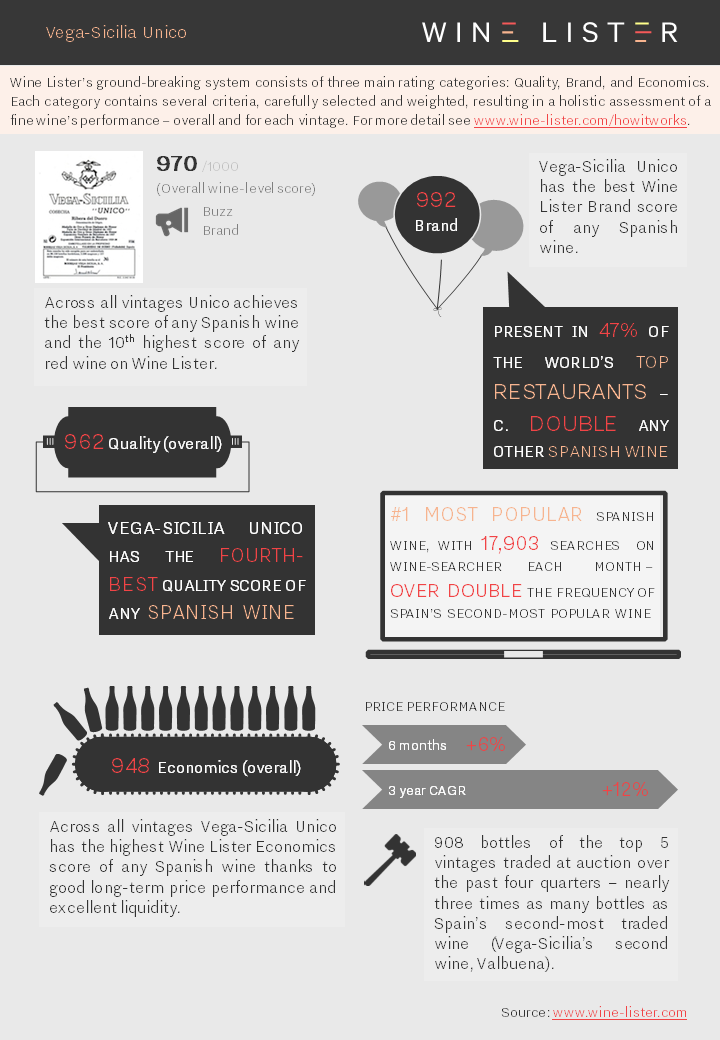
You can download the slide here: Wine Liser Fact Sheet Vega-Sicilia Unico
This week’s top five takes Wine Lister to the Douro Valley in search of its vintage ports. In some ways this top five is very much a four plus one, with the fifth placed Quinta do Noval Nacional, costing nine to ten times more than each of the others. It is also the only one to enjoy Buzz Brand status. At a total Wine Lister score of 880 and £521 per bottle, against the top-ranked Taylor’s 932 and £60, that constitutes quite a buzz.
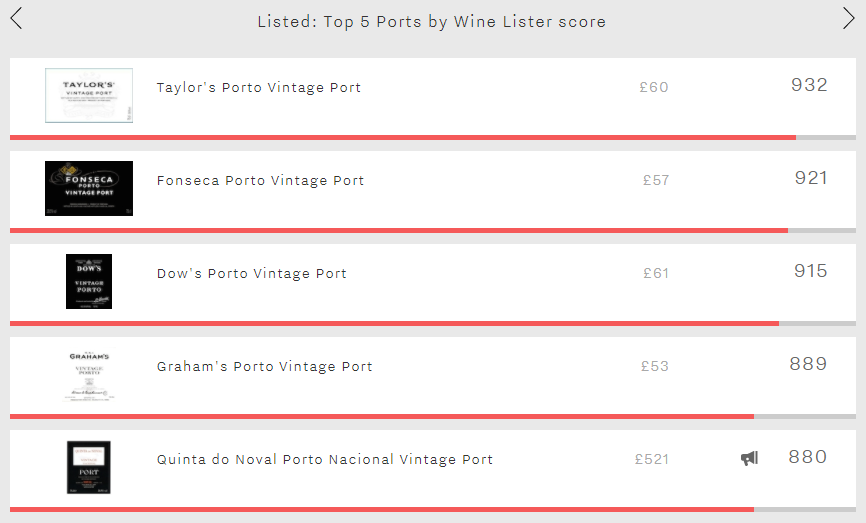
Here is a classic case of all metrics count but some count for more than others when it comes to cost. With a stonking 981 for Quality and the longest drinking window in its peer group the Quinto do Noval is clearly the nichest of the niche; its relatively low restaurant presence (9%) and monthly searches (2,457, on average, to Taylor’s 10,787) make its Wine Lister Brand score (825) well below Taylor’s and the other three.
With an overall score of 932, an excellent Quality score of 967, and a Brand score of 965 based on decent restaurant presence (23%) and over 10,700 average monthly searches, Taylor’s tops the Vintage ports. Fonseca comes a close second at an overall 921. With almost identical Quality (965) and slightly lower Brand (942), Fonseca just pips Taylor’s for liquidity, with 1,072 (against 1,061) of its top five vintages traded at auction in the past year.
At around £60 per bottle on average, Taylor’s and Fonseca are each affordable flutters with future Christmases in mind. Even illustrious older vintages such as 1970 and 1977 – in their drinking prime this Christmas – can be found at two to three times the price.
The same goes for third-placed Dow’s (£61) and fourth-placed Graham’s (£53). At an overall 915 Dow’s has a slightly lower Quality score than the top two. 943 is nevertheless still highly creditable. Graham’s edges Dow’s on Quality at 948 but a relatively lowly 650 for Economics brings it down to 889 overall.
All in all, Taylor’s and Fonseca merit their top two spots. If Santa has very deep pockets then consider adding Quinto do Noval 1994 to your wishlist (at a cool £1,229).
Brands such as Sassicaia or Masseto are virtually household names. Known to most as ‘Super Tuscans’, the unofficial ‘Crus Classés’ of Tuscany’s IGT-elite have garnered a reputation for high quality and investment calibre over the last 20 years, and have a price tag to match.
Most would agree that the first Super Tuscan was Sassicaia, produced by Mario Incisa della Rocchetta, who planted Cabernet Sauvignon for his family’s own personal stock, before releasing it commercially from 1968.
The early Super Tuscan sought to by-pass the DOC system and rules banning international varieties. Labelled simply as ‘vino da tavola’, consumers were able to decide for themselves on the quality of the liquid in the bottle. Meanwhile, Sassicaia earnt its own DOCG in 2013, and has the strongest brand in Italy and one of the strongest in the world – but what of the rest?
Last month Wine Lister explored Italy’s top wines for Economics, and found that the economic profiles of Piedmont’s top wines (Barolo and Barbaresco), beat their Tuscan counterparts. So what can consumers expect from Tuscany, apart from an idyllic holiday destination?
The Tuscan crown for Brand scores still firmly sits on the heads of the big five (Sassicaia, Tignanello, Ornellaia, Masseto, and Solaia), but with a little more digging, exceptional quality can certainly be found beyond these few names. Indeed, eight of Wine Lister’s top 10 Italian Value Picks by Quality score come from the country’s central region:
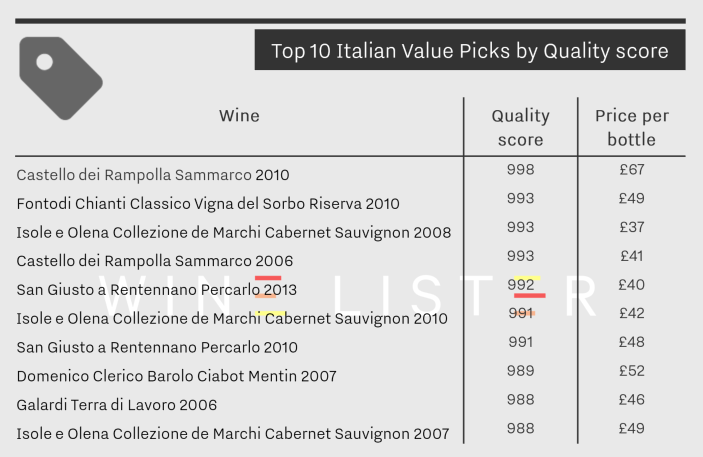
Value Picks are defined as wines with the best quality-to-price ratio, with an emphasis on quality. Of the Tuscan entries, only one is a DOCG – the Chianti Classico Vigna del Sorbo Riserva 2010 from Fontodi. The others are IGT, or ‘Super Tuscan’, such as Castello dei Rampolla Sammarco 2006 and 2010, and San Giusto a Rentannano Percarlo 2010 and 2013.
On average, Super Tuscan Value Picks cost £26 per bottle, and achieve Quality scores of 864. Meanwhile Super Tuscan Buzz Brands cost six times as much for the for an average Quality score of 889.
Whether Tuscany’s classification system will be able to define a true quality hierarchy in time is not clear. In the meantime, Wine Lister’s scoring system sheds some light on where the real value of Tuscany lies.
Also featured: Isole e Olena Collezione de Marchi Cabernet Sauvignon; Domenico Clerico Barolo Ciabot Mentin; Galardi Terra di Lavoro














